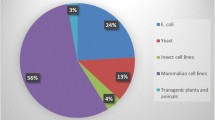Abstract
Chinese Hamster Ovary (CHO) cells are used for the production of therapeutic proteins. This work examines improving passaging growth rate of two CHO clones. Growth rates were significantly improved for both clones with supplementation of the nucleosides cytidine, hypoxanthine, uridine, and thymidine to the culturing media at the optimal concentration of 100 µM of each nucleoside. We investigated supplementing the same combination of nucleosides to seed bioreactors and production fed batch bioreactors. In the seed bioreactors, growth rate and harvest density were improved. However, in the production fed batch bioreactors, no improvements in growth rate or peak viable cell density were observed. Cell cycle analysis of the passaging cells provides evidence that nucleosides can affect the cell cycle. It is not clear from our work how the nucleosides impact the cell cycle regulatory pathways. Overall, nucleoside supplementation in cell culture media is an effective approach for improving growth rate in passaging and seed bioreactors of certain CHO cells.





Similar content being viewed by others
References
Aird KM, Zhang G, Li H, Tu Z, Bitler BG, Garipov A, Wu H, Wei Z, Wagner SN, Herlyn M, Zhang R (2013) Suppression of nucleotide metabolism underlies the establishment and maintenance of oncogene-induced senescence. Cell Rep 3:1252–1265
Austin WR, Armijo AL, Campbell DO, Singh AS, Hsieh T, Nathanson D, Herschman HR, Phelps ME, Witte ON, Czernin J, Radu CG (2012) Nucleoside salvage pathway kinases regulate hematopoiesis by linking nucleotide metabolism with replication stress. J Exp Med 209:2215–2228
Bester AC, Roniger M, Oren YS, Im MM, Sarni D, Chaoat M, Bensimon A, Zamir G, Shewach DS, Kerem B (2011) Nucleotide deficiency promotes genomic instability in early stages of cancer development. Cell 145:435–446
Gagnon M, Hiller G, Luan YT, Kittredge A, DeFelice J, Drapeau D (2011) High-end pH-controlled delivery of glucose effectively suppresses lactate accumulation in CHO fed-batch cultures. Biotechnol Bioeng 108:1328–1337
Guarnieri S, Pilla R, Morabito C, Sacchetti S, Mancinelli R, Fanò G, Mariggio MA (2009) Extracellular guanosine and GTP promote expression of differentiation markers and induce S-phase cell-cycle arrest in human SH-SY5Y neuroblastoma cells. Int J Dev Neurosci 27:135–147
Kanehisa M, Goto S (2000) KEGG: kyoto encyclopedia of genes and genomes. Nucleic Acids Res 28:27–30
Landauer K (2014) Designing media for animal cell culture: CHO cells, the industrial standard. Animal Cell Biotechnology, Humana Press, Totowa, pp 89–103
Lane AN, Fan TWM (2015) Regulation of mammalian nucleotide metabolism and biosynthesis. Nucleic Acids Res 43:2466–2485
Media Formulations (2019) Sigma-Aldrich. https://www.sigmaaldrich.com/life-science/cell-culture/learning-center/media-formulations.html
Nyhan WL (2005) Nucleotide synthesis via salvage pathway. Encyclopedia of Life Sciences. Wiley. https://doi.org/10.1038/npg.els.0003909
Ohana G, Bar-Yehuda S, Barer F, Fishman P (2001) Differential effect of adenosine on tumor and normal cell growth: focus on the A3 adenosine receptor. J Cell Physiol 186:19–23
Takagi Y, Kikuchi T, Wada R, Omasa T (2017) The enhancement of antibody concentration and achievement of high cell density CHO cell cultivation by adding nucleoside. Cytotechnology 69:511–521
Tang D, Lam C, Louie S, Hoi KH, Shaw D, Yim M, Snedecor B, Misaghi S (2017) Supplementation of nucleosides during selection can reduce sequence variant levels in CHO cells using GS/MSX selection system. Biotechnol J 13:1700335
Vermeulen K, Van Bockstaele DR, Berneman ZN (2003) The cell cycle: a review of regulation, deregulation and therapeutic targets in cancer. Cell Prolif 26:131–149
Acknowledgements
The authors would like to acknowledge Paulena Lieske for her help setting up and running the Fortessa® for the cell cycle analysis. The authors would like to acknowledge Dawn Erikson-Stapleton, Matt Gagnon, and Greg Hiller for their comments and suggestions during manuscript preparation.
Author information
Authors and Affiliations
Corresponding author
Ethics declarations
Conflict of interest
The authors declare no financial or commercial conflict of interest.
Additional information
Publisher's Note
Springer Nature remains neutral with regard to jurisdictional claims in published maps and institutional affiliations.
Rights and permissions
About this article
Cite this article
Morrison, C., Bandara, K., Wang, W. et al. Improvement of growth rates through nucleoside media supplementation of CHO clones. Cytotechnology 71, 733–742 (2019). https://doi.org/10.1007/s10616-019-00319-0
Received:
Accepted:
Published:
Issue Date:
DOI: https://doi.org/10.1007/s10616-019-00319-0




